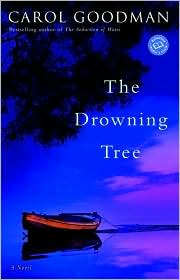Carol Goodman
Juno McKay's life hasn't turned out exactly as she planned it, but that okay since she has her beautiful daughter Bea, and her best friend Christine to make up for all of the short coming. While at her 15th College reunion she witnesses Christine give a speech that shakes the ground that Penrose was built on. When Christine ends up missing Juno must investigate some of her outrageous claims and figure out were they enough to get her killed.
The Drowning Tree is the definition of mediocre. Juno's interesting, but not really interesting. She lives in a stained glass factory which she now also runs (+1 interesting point) but she's really overprotective of her daughter, doesn't really date and apparently hasn't done anything interesting since her ex-husband tried to kill her (-2 ). Since this is really all Juno is about she doesn't really have much spirit to carry the store, which is sad, because the plot doesn't really put in much effort either. In The Drowning Tree everything is about imagery. There are intense descriptions of settings, like the mental hospital Neil is in and the Penrose estates, as well as art and the river by the McKays. While not a fault in itself, using beautiful descriptions to supplement the already overworked and barely functional plot isn't a huge selling point.
While I have several other issues with The Drowning Tree, the one that really sealed it's back of the bookshelf shame is the Penrose diary. Usually Goodman is fantastic at telling a story within a story, pacing them out so that the reader is interested in both and using a device that makes sense and is intriguing to the reader to tell said second story. The diary entries are short and not very insightful. They become more about Juno's assumptions than about the Penrose sisters reality. Not the best way to add in a story, especially when it is needed to make scenes of the entire rest of the book.


No comments:
Post a Comment